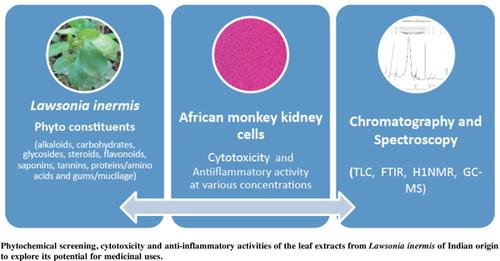Medicinal Chemistry ( IF 2.3 ) Pub Date : 2021-06-30 , DOI: 10.2174/1573406416666200221101953 Anju Manuja 1 , Nitu Rathore 1 , Shalki Chaudhary 1 , Balvinder Kumar 1

|
Background: Lawsonia inermis Linn popularly known as Henna, plays an important role in ayurvedic or natural herbal medicines. The presence of phytoconstituents in henna, that may affect the animal or human health adversely, needs to be elucidated for L. inermis Linn species grown in India.
Introduction: The aim of this research was to perform phytochemical screening, and study cytotoxicity and anti-inflammatory activities to understand the potential of leaves of Lawsonia inermis of Indian origin to provide a way forward for therapeutic use in medicine.
Methods: We assessed the phytochemical profile for the presence of phytoconstituents (alkaloids, carbohydrates, glycosides, steroids, flavonoids, saponins, tannins, proteins/amino acids and gums/mucilage) in various extracts of the plant leaves. The extracts were further purified by column chromatography for the isolation of plant constituents and monitored by TLC, analyzed by Fourier transform infrared FT-IR spectroscopy, H1NMR, and GC-MS analysis. Fractions were assessed for cytotoxicity and anti-inflammatory properties at various concentrations. We assessed the anti-inflammatory activity by nitric oxide production in various leaf extracts determined by Griess assay.
Results: All the spectral results suggest that the compounds from the extract contain an aromatic nucleus and OH group along with the methoxy group, allyl as well as vinyl group. Fractions of chloroform/methanolic (7:3) leaf extract of Lawsonia inermis confirmed the presence of the two constituents i.e. fraxetin and 1(3H)-isobenzofuranone. We observed a significant difference in cytotoxicity at higher concentrations in methanol and chloroform: methanol (8:2) leaf extracts (p>0.05), we could not find any significant differences amongst other leaf extracts at different concentrations. Some leaf extracts have potential cytotoxic activity on Vero cells. Reducing the chloroform concentration during extraction decreases the cytotoxic effect on cells. Nitric oxide levels decreased from 1000 μg/ml concentration to lower concentrations with varying degrees. Overall the highest nitric oxide production by CHCl3 (70%)/ MeOH (30%) was observed amongst various fractions at different concentrations.
Conclusion: Phytochemical screening and the study of cytotoxicity and anti-inflammatory activities highlight the potential of leaves of the plant to provide a way further for their use in medicine. Fraxetin 1(3H) and isobenzofuranone structures were confirmed in fractions of CHCl3 (70%)/ MeOH (30%) extract as potent constituents. Some leaf extracts have potential cytotoxic activity on Vero cells. Reducing the chloroform concentration during extraction, it decreases the cytotoxic effect on cells. The cytotoxicity studies indicate the presence of cytotoxic compounds in some of these extracts, warranting research for the fabrication of suitable formulations comprising these constituents to reduce dose/toxicity for beneficial effects of the plant components.
中文翻译:

印度劳森尼亚无针叶提取物的植物化学筛选、细胞毒性和抗炎活性,以探索其药用潜力
背景:Lawsonia inermis Linn 俗称指甲花,在阿育吠陀或天然草药中发挥重要作用。指甲花中植物成分的存在可能对动物或人类健康产生不利影响,需要对印度种植的 L. inermis Linn 物种进行阐明。
介绍:本研究的目的是进行植物化学筛选,研究细胞毒性和抗炎活性,以了解印度劳森尼亚无叶草叶子的潜力,为医学治疗提供一条前进的道路。
方法:我们评估了植物叶子的各种提取物中存在的植物成分(生物碱、碳水化合物、糖苷、类固醇、黄酮类化合物、皂苷、单宁、蛋白质/氨基酸和树胶/粘液)的植物化学特征。提取物通过柱色谱进一步纯化以分离植物成分,并通过 TLC 监测,通过傅里叶变换红外 FT-IR 光谱、H1NMR 和 GC-MS 分析进行分析。在不同浓度下评估馏分的细胞毒性和抗炎特性。我们通过 Griess 测定法测定的各种叶提取物中的一氧化氮产生来评估抗炎活性。
结果:所有光谱结果表明提取物中的化合物含有芳香核和 OH 基团以及甲氧基、烯丙基和乙烯基。Lawsonia inermis 的氯仿/甲醇 (7:3) 叶提取物的馏分证实了两种成分的存在,即 fraxetin 和 1(3H)-异苯并呋喃酮。我们观察到更高浓度的甲醇和氯仿:甲醇 (8:2) 叶提取物的细胞毒性存在显着差异(p>0.05),我们在不同浓度的其他叶提取物中未发现任何显着差异。一些叶提取物对 Vero 细胞具有潜在的细胞毒活性。在提取过程中降低氯仿浓度会降低对细胞的细胞毒性作用。一氧化氮水平从 1000 μg/ml 浓度下降到不同程度的较低浓度。总体而言,CHCl3 产生的一氧化氮最高在不同浓度的各种级分中观察到3 (70%)/MeOH (30%)。
结论:植物化学筛选以及细胞毒性和抗炎活性的研究突出了植物叶子的潜力,为它们在医学中的应用提供了进一步的途径。Fraxetin 1(3H) 和异苯并呋喃酮结构在 CHCl 3 (70%)/MeOH (30%) 提取物的馏分中被证实为有效成分。一些叶提取物对 Vero 细胞具有潜在的细胞毒活性。在提取过程中降低氯仿浓度,可降低对细胞的细胞毒作用。细胞毒性研究表明,这些提取物中的一些提取物中存在细胞毒性化合物,因此需要研究制造包含这些成分的合适制剂,以降低剂量/毒性,从而实现植物成分的有益效果。



























 京公网安备 11010802027423号
京公网安备 11010802027423号